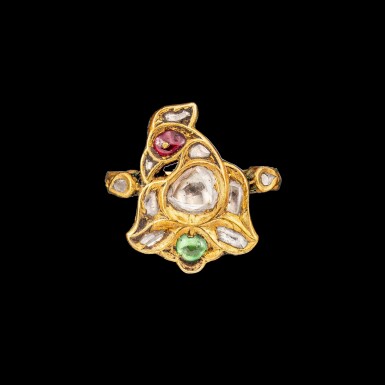
Property from the Tuyet Nguyet and Stephen Markbreiter Collection 雪月藏亞洲藝術珍品
A rare gold, diamond, ruby and emerald 'bird' ring Jaipur, North India, 19th century | 十九世紀 北印度齋浦爾 金嵌鑽石、紅寶及祖母綠鳥形戒指 背飾琺瑯彩鳥紋
Lot Closed
July 28, 02:19 AM GMT
Estimate
26,000 - 28,000 HKD
Lot Details
Description
Property from the Tuyet Nguyet and Stephen Markbreiter Collection
A rare gold, diamond, ruby and emerald 'bird' ring
Jaipur, North India, 19th century
雪月藏亞洲藝術珍品
十九世紀 北印度齋浦爾 金嵌鑽石、紅寶及祖母綠鳥形戒指 背飾琺瑯彩鳥紋
the reverse depicting a peacock with red, white, blue and green meenakari
d. 1.8 cm; 6.8 grams
In the late 16th century, Mughal court goldsmiths ingeniously combined enamelling with the kundan setting technique. This sophisticated art form came to India during the Mughal invasion and has been practised in India ever since. Such lavish ornamentation is evident in a kada bangle (lot 1023) and a 'bird' ring (lot 1019) in this collection.
In India, the art of enamelling is known as meenakari. The word meenakari means to place paradise onto an object. Jaipur artisans perfected this art form and developed their distinctive style. It is defined by the vivid red colour and the intricate designs enamelled on the back or inner surfaces of ornaments. The enamelled details remain unseen, adding hidden interest that only the wearer knew about.
In lot 1023, the inner surface of the kada bangle is exquisitely decorated with pairs of peacocks enamelled in vibrant shades of blue and green, against a floral design picked out in vivid red. While the reverse of the 'bird' ring (lot 1019) enamelled with a peacock in green, white, red and blue, echoing the front design and choice of gems - emerald, diamond and ruby.
These two pieces reveal that meenakari work requires a great deal of attention and precision. The craftsmen have to first engrave a complex design onto a small surface area, chisel off the grooves before filling in the tiny spaces with enamels. Meenakari adds greater artistic value to the piece and has a pragmatic reason behind it. It protects the high-karat gold from abrasion due to frequent skin contact, and gives the jewellery piece the rigidity necessary to keep its form.
Another known characteristic of Indian jewellery is the kundan setting technique. It is a process of setting gemstones with thin sheets of pure gold, or kundan. This sophisticated technique allows precious stones of any size or shape to be set directly into fragile enamelled surfaces.
十六世紀末,莫臥兒帝國的金匠巧妙地結合了琺瑯和「昆丹」(kundan)工藝鑲嵌技術。其技術流傳至印度大陸,一直沿用至今。雪月收藏中的 拍品1023 嵌寶摩羯首手鐲及 拍品1019 金嵌寶鳥形戒指,正是這精細珠寶工藝的典範,造型奢侈華麗。
印度人稱琺瑯彩為「meenakari」,這一詞富有詩意,意指將「將天堂置於飾物之中」。而印度之中,齋浦爾的工匠特別精通meenakari,獨創了別樹一幟的風格。其一特色為其紅色琺瑯彩特別鮮艷。其二為工匠只於珠寶的背面或內部上彩,佩戴時候隱藏了上彩細節,只為珠寶擁有者才知道上了琺瑯彩的紋飾,大大增加珠寶的神秘感。
拍品1023的嵌寶摩羯首手鐲内,繪有多對色彩艷麗的孔雀,鳥身飾藍、綠彩,與背景鮮紅色的花卉形成强烈視覺對比。拍品1019金嵌寶鳥形戒指的背面飾琺瑯彩孔雀紋飾,呼應著戒指前面的設計及鑽石、紅寶及祖母綠的顏色。
這兩件首飾反映meenakari所需的細心和精準度。工匠首先需在首飾金面上雕刻複雜的花紋細節,再鑿走幼細的琺琅槽,再將琺琅料點在首飾上。Meenakari一方面可以為首飾增添了立體美感,大大提高了首飾的藝術價值。另一方面,也能保護高純度的黃金,免黃金受磨蝕,使首飾更堅硬,能夠保持原狀。
「昆丹」(kundan)工藝鑲嵌技術涉及固定寶石於黃金箔條之中。如此精密的技巧有助工匠自如鑲嵌任何大小及形狀的寶石。
You May Also Like










